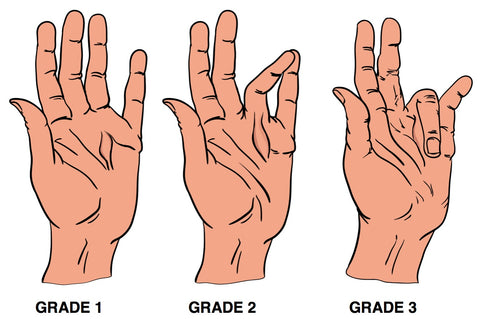Treatment for Dupuytren’s Contracture

Dupuytren's Contracture
Maureen Abson demonstrates palm massage for Dupuytren's Contracture
Dupuytren’s contracture is a condition that can cause the fingers to contract, sometimes meaning that the person loses normal functioning of the hands.
First, to explore some of the myths that surround Dupuytren’s, this condition is not caused by overuse, operating machinery, or too much golf, nor is it a virus.
Rather it is a thickening of the connective tissue below the skin—but on top of the tendons. In this way it is similar to scar tissue, and as it builds it pulls the fingers forward.
Its exact cause is unknown but it is thought to have a genetic link, so runs in families. It is most common in the hands but can also occur in the knuckles, the soles of the feet, and, for some men, it can develop in the penis, causing a curvature.

Three grades of dupuytren's contracture have been described (see below)
Three Grades of Dupuytren's Contracture
Three grades of dupuytren's contracture have been described, based on the characteristics of the fibrous tissue deformity and the presence of a contracture.
-
Grade 1: thickened nodule and a band in the palmar aponeurosis that may progress to skin tethering, puckering, or pitting.
-
Grade 2: peritendinous band with limited extension of the affected finger.
-
Grade 3: presence of flexion contracture.
Who's at Risk?
Dupuytren’s contracture is more common in men than women and is mainly a condition of middle age and onward. When women do get it they tend to present less severe symptoms.
Men of northern European heritage seem to be at much greater risk than other groups. There appears to be an increased chance of men with Dupuytren’s contracture also developing diabetes, but this is not yet fully understood.
Symptoms
The condition is normally painless, but is very inconvenient as the affected fingers become progressively and permanently difficult, or impossible, to use.
Surgery is often carried out to release the fingers, but with mixed results. Other specialists recommend injections or radiation treatment, but for some these cause unpleasant side effects.

Dupuytren’s contracture - Check for this trigger point in Trigger Point in Palmaris Longus
Trigger Points
Myofascial trigger points in the palmaris longus or other forearm muscles may contribute to either pain or movement restrictions that may exacerbate the fibrous restriction process.
When treating this problem, take care to address the forearm muscles and any other soft tissues of the upper extremity that might also be contributing to further tension in the palmar fascia.

About Niel Asher Education
Niel Asher Education (NAT Global Campus) is a globally recognised provider of high-quality professional learning for hands-on health and movement practitioners. Through an extensive catalogue of expert-led online courses, NAT delivers continuing education for massage therapists, supporting both newly qualified and highly experienced professionals with practical, clinically relevant training designed for real-world practice.
Beyond massage therapy, Niel Asher Education offers comprehensive continuing education for physical therapists, continuing education for athletic trainers, continuing education for chiropractors, and continuing education for rehabilitation professionals working across a wide range of clinical, sports, and wellness environments. Courses span manual therapy, movement, rehabilitation, pain management, integrative therapies, and practitioner self-care, with content presented by respected educators and clinicians from around the world.
Known for its high production values and practitioner-focused approach, Niel Asher Education emphasises clarity, practical application, and professional integrity. Its online learning model allows practitioners to study at their own pace while earning recognised certificates and maintaining ongoing professional development requirements, making continuing education accessible regardless of location or schedule.
Through partnerships with leading educational platforms and organisations worldwide, Niel Asher Education continues to expand access to trusted, high-quality continuing education for massage therapists, continuing education for physical therapists, continuing education for athletic trainers, continuing education for chiropractors, and continuing education for rehabilitation professionals, supporting lifelong learning and professional excellence across the global therapy community.

Continuing Professional Education
Looking for Massage Therapy CEUs, PT and ATC continuing education, chiropractic CE, or advanced manual therapy training? Explore our evidence-based online courses designed for hands-on professionals.


















